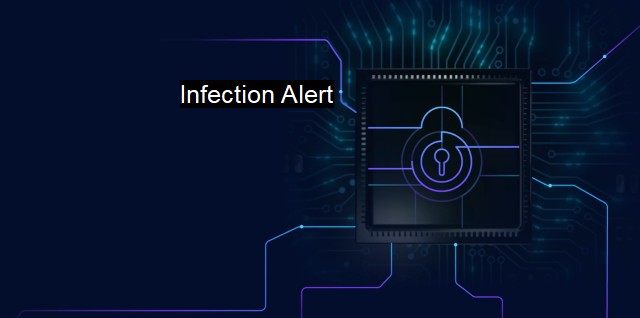What is Infection Alert?
Infection Alert: Strengthening Cybersecurity through Proactive Detection and Response
"Infection Alert" within the context of cybersecurity and antivirus refers to the warning or notification that a user receives when their device or network has been targeted by malicious software, more commonly known as malware. An infection alert is an alarm raised by an antivirus or anti-malware program to inform the user about a potential threat or a confirmed attack on their system. It is essentially the siren that goes off, warning the system operator about the infection.Cybersecurity is the practice of protecting the integrity of networks, devices, and data from virtual threats. Its primary aim is securing confidential and sensitive information, thereby enabling safe operations in an interconnected world. The foundation of robust cybersecurity lies in understanding the manifold threats positioned against it. These threats manifest in different forms - viruses, worms, troophagy, botnets, ransomware, spyware, adware etc. An "Infection Alert" is often the first line of defense against these potential threats as it signals that something untoward is happening, instigating immediate protective action.
Antivirus is a type of cybersecurity software designed to safeguard a computer system against these various forms of harmful software. Antivirus programs achieve this by running regular scans through files and systems to identify and remove malicious software, securing the system's breach points, and consequently ensuring data and operations remain unharmed. Subsequently, an 'infection alert’ generated by these antivirus softwares signals when these malicious elements make their way into the system or file.
The premise of an 'infection alert' is based on predefined threat definitions that these anti-malware programs possess. The antivirus softwares use threat signatures - specific characteristics of a known malicious code – to search for potential threats. Once such a predefined threat makes an appearance in any file on the system, the protective software triggers an infection alert.
In bills of severity, there are varied degrees to these alerts ranging from low-risk popup ads to high-risk stealth attacks that can result in substantial information loss. When an 'infection alert' is flagged, the antivirus software subsequently prompts the user with various options for taking immediate action. The action can range from merely notifying the user, isolating the particular file or program causing the issue, deleting it entirely and, and in drastic situations, initiating a more comprehensive antivirus scan.
It's crucial to note that an 'Infection Alert' by itself can’t entirely protect a system from a potential attack – its main function is to primarily inform of an impending threat; the secondary actions undertaken post the alert are of utmost importance. The efficacy of the antivirus software becomes evident by how competently it contains and removes the threat post the alert notification, and whether it successfully hardens the system to resist future attacks.
If an 'Infection Alert' flags up on a device, it is essential for the user to act immediately to mitigate potential damage. Ignoring infection alerts can lead to devastating consequences, including but not limited to, slowed system performance or even a complete system failure, theft of personal and financial information, private data becoming publicly accessible amongst other risks.
An "Infection Alert" plays a pivotal role in the context of cybersecurity and antivirus methods. It serves as an early-warning system against potential attacks, allowing users to take necessary protective measures. User awareness and the efficiency of installed anti-malware software directly impact the effectiveness of an infection alert. prevention is always better than cure; hence, to prevent needing an infection alert in the first place, it is advisable for users to practice safe habits - avoiding suspicious emails or links, updating and patching systems routinely, utilizing secure, encrypted connections, frequent data backup, to name a few- in the digital world we inhabit currently.

Infection Alert FAQs
What is Infection Alert?
Infection Alert is a feature of antivirus software that alerts users when it detects a virus or malware on their computer. It serves as a warning to take action to protect the system from further harm.How does Infection Alert work?
Infection Alert works by scanning files and programs on a computer for signs of malicious code. If it detects any suspicious activity, it will generate an alert to notify the user of the potential threat.What should I do if I receive an Infection Alert?
If you receive an Infection Alert, it is important to take action immediately. Follow the instructions provided by your antivirus software, which may include quarantining or deleting the infected file, running a full system scan, or seeking assistance from a cybersecurity professional.Can Infection Alert prevent all cyber threats?
While Infection Alert can help protect your system from a variety of cyber threats, including viruses, malware, and spyware, it is not foolproof. It is important to practice safe browsing and computing habits, such as keeping your software and operating system up to date, avoiding suspicious emails and downloads, and using strong passwords.| | A | | | B | | | C | | | D | | | E | | | F | | | G | | | H | | | I | | | J | | | K | | | L | | | M | |
| | N | | | O | | | P | | | Q | | | R | | | S | | | T | | | U | | | V | | | W | | | X | | | Y | | | Z | |
| | 1 | | | 2 | | | 3 | | | 4 | | | 7 | | | 8 | | |||||||